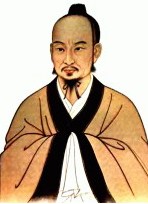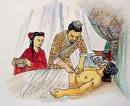Four Diagnostic Methods
Four Diagnostic Methods :Oberving, Listening, Asking and Feeling 望闻问切






The Diagnostic Method is an important component of Traditional Traditional Medicine. In TCM there are Four Diagnostic Methods, namely Observing(望), Listening(闻), Asking(问)and Feeling(切), which are four basic methods and procedures used in diagnosing a disease. They are the presuppositions of correct differentiation and effective treatment in TCM.
The Four Diagnostic Methods of TCM has a long history, which was found by Bian Que(扁鹊), a famous physician in the Warring States Period. Bian Que was skillful in observing the complex environment of the patient to diagnose disease and estimate the disease envolvement. The story of "Bian Que met the King of Cai" was about Bian Que's exact diagnoses on the envolvement of disease through observing the comlex envolvement of the King of Cai. Since then, the Diagnostic Method was continuously perfected and inherited by physicians of later dynasties in clinic practices.
Observing the patient's spirit, body, demeanour, head, face, skin,tongue, etc.
Listening to the patient's voice, breath, cough, etc.
Asking the patient's living condition, environment, including emotional environment and family environment, ect.
Feeling the patient's palpitation of pulse, which is an extremely complex method.
Palpitation of the skin, limbs, hands, chest, abdomen and points are also considered. It can offer the physician a great deal of valuable information about the internal condition of the patient. It's said that there are twenty-eight different kinds of pulse, each of which can give the physician a great insight to the solution of the patient's disease.
The Four Diagnostic Methods is unique in Traditional Chinese Medicine. It is a conplete subject of science which consists of theories, methods, technologies and appliances and it was formed along with the continuously medical practice of the TCM. At present, it has been included into the List of National Intangible Cultural Heritage.
In Traditional Chinese Medicine, the holistic approach refers to the integration of the body and its relationship with the natural world. The body is an organic whole and its functions are interconnected.There is a close relationship between the body, natural, geographic, working and family environments. Weather changes, season changes, family moving from one place to another, a fiendly or unfriendly boss or colleague, happy or unhappy family all infuluence the body health. TCM holds that man cannot only actively adapt to nature, but also remold it, so as to increase the level of health and reduce disease.
For example, the meridian system links the body as a whole and transports vital energy to maintain the harmony of the physiological activities for all parts of the body. If the energy and Xue cannot be transported to a part of the body, this part of body even the whole body will not perform normally and you may fell uncomfortable, pain or sickness. In daily life, a small cut in the fingue could cause a whole body symptom such as pain or high fever.